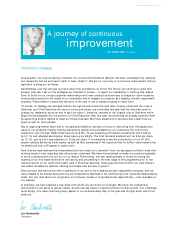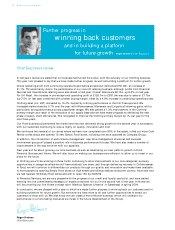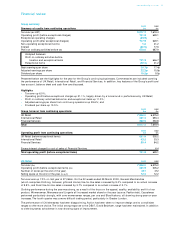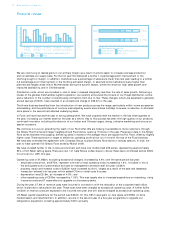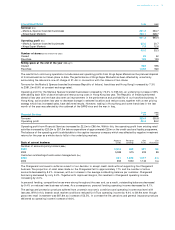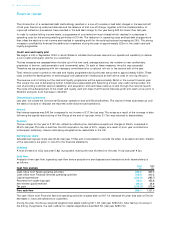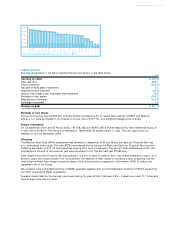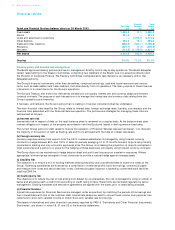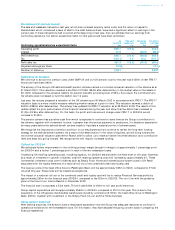Marks and Spencer 2003 Annual Report Download - page 13
Download and view the complete annual report
Please find page 13 of the 2003 Marks and Spencer annual report below. You can navigate through the pages in the report by either clicking on the pages listed below, or by using the keyword search tool below to find specific information within the annual report.
www.marksandspencer.co m 11
Remuneration Committee: ensures the executive directors and senior management are appropriately rewarded, giving
due regard to the financial and commercial health of the Group. It comprises three non-executive directors, is chaired by
Dame Stella Rimington, and meets formally five times per year. The Remuneration Report appears on pages 13 to 20 and
contains a statement of remuneration policy and details of the remuneration of each director.
The remuneration of non-executive directors is determined by the Chairman together with the executive Board. In
accordance with the Combined Code, the Board considers each year whether shareholders should be invited to consider
separately the Remuneration Report at the AGM and is proposing a separate resolution to shareholders at the 2003 AGM,
as also required by new legislation.
Nomination Committee: ensures there are appropriate procedures in place for the nomination, selection, training and
evaluation of directors and that successional plans are in place. It receives a report twice per year from the Company
Chairman on Board structure, size, composition and successional needs, thereby keeping under review the balance of
membership between executive and non-executive directors and that the Board has the required blend of skills and
experience. It comprises all the non-executive directors together with Luc Vandevelde, is chaired by Brian Baldock, and
meets formally twice per year.
Corporate Social Responsibility (‘CSR’) Committee: provides the Board with an overview of the social, environmental and
ethical impacts of the Group’s activities. It is chaired by Luc Vandevelde, comprises main Board members (executive and
non-executive) and senior management and meets formally three times per year. The Group’s risk assessment process
is applied to identify key CSR risks and opportunities in areas such as product safety, sustainable raw materials, animal
welfare, ethical trading, employment policy, health and safety and community involvement. The Committee then reviews
strategy, policy development and performance within this framework. The Group’s first CSR Review is available from the
website at www.marksandspencer.com/the company or by telephoning 0800 591 697.
Relations with shareholders
The Group is committed to ongoing communication across its entire shareholder base, whether institutional investors,
private or employee shareholders. This is achieved principally through annual and interim reports, quarterly trading
statements and the AGM. The Group’s website at www.marksandspencer.com contains corporate and customer information
updated on a regular basis.
Regular dialogue and presentations take place throughout the year with institutional investors. The AGM, held in July in
London, is well attended by shareholders who receive a business presentation and have the opportunity to ask questions of
the full Board including the chairs of the Audit, Remuneration and Nomination Committees. The results of the proxy voting
are declared at the meeting and are published on the Group’s website together with a resumé of the meeting.
Accountability and audit
Responsibility for risk and internal control
The Group’s overriding corporate objective is to maximise long-term shareholder value whilst exceeding the needs of our
customers, employees and partners. In doing so, the directors recognise that creating value is the reward for taking and
accepting risk.
The Board has overall responsibility for the Group’s approach to assessing risk and systems of internal control, and for
monitoring their effectiveness in providing shareholders with a return that is consistent with a responsible assessment
and mitigation of risks. This includes reviewing financial, operational and compliance controls and risk management
procedures. The role of executive management is to implement the Board’s policies on risk and control, and present
assurance on compliance with these policies. Further independent assurance is presented by an internal audit function,
which operates across the Group, and the external auditors. All employees are accountable for operating within
these policies.
Because of the limitations that are inherent in any system of internal control, this system is designed to manage, rather than
eliminate, the risk of failure to achieve corporate objectives. Accordingly, it can only provide reasonable but not absolute
assurance against material misstatement or loss.
Risk assessment
The Board has established an ongoing process for identifying, evaluating and managing the significant risks faced by the
Group. As an integral part of planning and review, management from each business area and major project identify their
risks, the probability of those risks occurring, the impact if they do occur and the actions being taken to manage those risks
to the desired level. This information is communicated upwards on a filter basis, culminating in a comparison with the
executive directors’ assessment of the Group’s risks and discussion by the Board of the Group Risk Profile.
This process has been in place for the year under review and up to the date of approval of the annual report and accounts.
It has been regularly reviewed by the Board and accords with the Internal Control Guidance for directors on the Combined
Code produced by the Turnbull Working Party.


